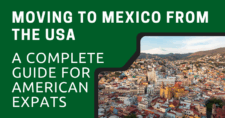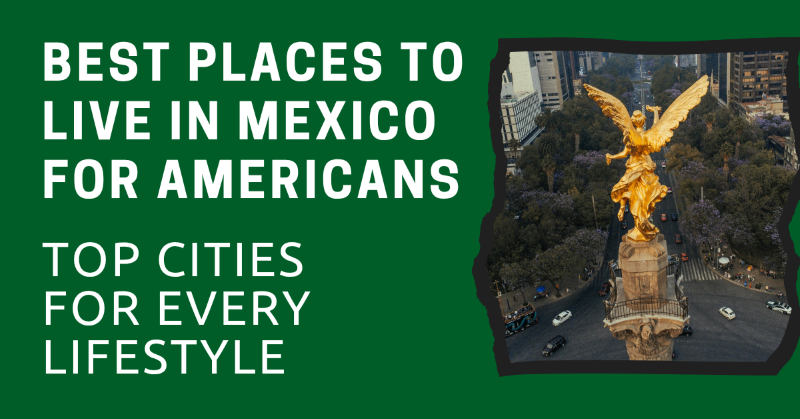
After years of living around Mexico, here’s my take on the best places for Americans, from Mexico City to peaceful Lake Chapala and sunny Puerto Vallarta. Find out what life’s really like in each city before you decide where to call home.
When I first thought about moving to Mexico, many of my friends and family members thought I was crazy. I was in my mid-40s when I got laid off during the Great Recession from a very stressful consulting job.
I needed a change. I decided to go on vacation to Puerto Vallarta to clear my mind. Ultimately, I stayed there for almost two years.
I had made several Mexican friends while living in Puerto Vallarta, and they had moved to Playa del Carmen to work. I contacted a couple of my Mexican friends who had moved to Playa del Carmen, who explained to me about the robust tourist economy.
I spent two years living in Playa del Carmen before taking the ferry across to Cozumel, where I spent an additional three years.
While living in Mexico for seven years, I had traveled extensively throughout the country trying to find that right mixture of history, affordability, culture, and American-style amenities.
I first visited my present-day home in southern Veracruz with some Mexican friends who grew up in the small town. I knew I adored the little town, but I also knew my Spanish was not sufficient to live there.
Well, after working hard on my Spanish, I moved to my favorite small town in southern Veracruz four years ago.
I don’t have the American-style amenities where I live today, but I have something more special. A community that treats me like one of their own.
I hope that everyone who moves to Mexico has a great experience. Planning and thinking about what you want to experience is necessary. Here is a quick guide on some of the best places for Americans to live in Mexico based on my decades of experience living in Mexico.
This article will take approximately 61 minutes to read. Don't have the time right now? No worries. Email the ad-free version of the article to yourself and read it later!
Disclaimer: This article may include links to products or services offered by ExpatDen's partners, which give us commissions when you click on them. Although this may influence how they appear in the text, we only recommend solutions that we would use in your situation. Read more in our Advertising Disclosure.
Contents
- Key Takeaways
- How to Choose Where to Live in Mexico as an American
- Key Factors to Weigh Before Moving
- Best Cities in Mexico for Americans
- Mexico City
- Mérida
- Lake Chapala (Ajijic/Chapala)
- Puerto Vallarta
- Guadalajara
- Playa del Carmen
- Other Worth-Mentioning Cities
- Comparing Cities in Mexico for American Expats
- Where Should You Live in Mexico?
Key Takeaways
- Mexico offers many lifestyles for Americans, from big-city living in Mexico City and Guadalajara to quiet lakeside life in Lake Chapala or beach living in Puerto Vallarta and Playa del Carmen.
- Mérida is one of the safest and most cultural cities, though it’s hot all year and knowing some Spanish helps.
- Lake Chapala is the easiest place for newcomers to adjust to because of its strong expat community and mild weather.
- Puerto Vallarta and Playa del Carmen are perfect for beach lovers who want modern conveniences and plenty of English-speaking locals.
- San Miguel de Allende and Cozumel suit those looking for smaller, artsy, or island-style communities with a relaxed pace.
- Every city has its own rhythm, so it’s best to visit a few before deciding where to settle down.
How to Choose Where to Live in Mexico as an American
One of the biggest questions Americans have about living in Mexico is where to live. For me, it took time and a bit of adventure. I started on the West Coast, then moved to the East Coast, and eventually along the Gulf of Mexico.
One thing is for sure: you need to plan on spending time in several places before making your choice. I would recommend choosing three cities or locations in Mexico. Then plan on spending a minimum of two to three weeks in each city or location. The actual time on the ground somewhere will help you determine where you feel comfortable.
While visiting the different locations, take memory notes and talk with as many different people as you can, including other Americans and the local people. Take mental notes on the availability of items that are important to you.
While visiting these different places, think about how your lifestyle would fit in or change there. Are your Spanish skills adequate? Is your budget sufficient?
Be honest with yourself. You’re moving to a foreign country. Honesty with yourself is necessary for a smooth transition.
Key Factors to Weigh Before Moving
There are some key factors you should take before moving and choosing a city to live in Mexico.
Are you going to take your household belongings with you?
Temporary and Permanent Residents are eligible for a one-time duty-free option for taking their household goods with them to Mexico. Check here for the requirements.
What’s your monthly budget?
You’ll need to find a location that you can afford and live the lifestyle you want. Staying on budget is important from the beginning of your move. Some cities like Mexico City have a higher cost of living than many cities.
How well do you speak Spanish?
Remember, even in areas that are heavily populated with Americans, you’ll still need to interact with locals, healthcare professionals, employees, and government officials. Formulating a plan to learn more Spanish either before or after your move is advised.
Check here for a complete guide for moving to Mexico.
What’s your preferred climate (tropical vs highland)?
Tropical areas along the coastlines and inland in the southern regions of Mexico are generally hot and humid. You’ll find little variation between the coastline’s climate, whether you’re on the Gulf of Mexico, Caribbean, or Pacific coasts.
Most months are hot and humid, with April and May being the warmest in the Caribbean, the Gulf of Mexico, and the southern regions of Mexico. Along the Pacific Coast, July to August are the warmest months, although the Baja Peninsula can be drier and not as hot. The Yucatan Peninsula is hot and humid from April to September, with little relief from the weather.
Remember, coastal areas in Mexico, including the Yucatan Peninsula, are subject to tropical storms, hurricanes, and prolonged periods of rain from May/June through October/November.
Puerto Vallarta, Playa del Carmen, and Cozumel are the best places for Americans to live in Mexico in tropical areas.
Highland and Central areas of Mexico boast warm to hot temperatures during the day and cooler temperatures in the evenings from March through September. October through February brings cooler to pleasant weather during the day and slightly frigid temperatures in the evening. In some places, you can experience snow in locations like Puebla, Veracruz, and some northern states along the United States border.
Mexico City, Guadalajara, Lake Chapala, and San Miguel de Allende are the best places for Americans to live in Mexico in highland areas.
Do you need access to U.S. flights?
Mexico has 66 international airports spread throughout the country. Mexico to the United States is the third-largest international route with over 400 daily flights, to and from various cities.
Travel time is easy, with most non-stop flights from Mexico to the United States taking less than six hours. Most Americans living in Mexico are within a couple of hours’ drive from an international airport.
Mexico City International Airport is the busiest in Mexico. Cancun International Airport has the highest volume of international travelers. Guadalajara International Airport is also a major hub for Americans flying to the United States, and Licenciado Gustava Díaz Ordaz International Airport from Puerto Vallarta offers an abundance of flights to San Francisco, Los Angeles, and Houston.
Smaller international airports like Cozumel, Veracruz, Leon, Queretaro, and Puebla only offer a few select daily or weekly flight options to the United States.
Best Cities in Mexico for Americans
With that long blurb, here are the best cities in Mexico for Americans. The list here are mainly based on my experience living in Mexico for decades.
Mexico City
Mexico City is perfect for Americans who want to explore a large, populated city with various attractions, including gorgeous architecture, diverse food, performing arts, sporting events, trendy nightlife, and museums.
Pros
- Access to American-style amenities, including high-end shopping, technology, and grocery stores.
- Mexico City has the best public transit system in all of Mexico. You’ll find that the buses, subway, or the train system can get you anywhere within the city easily.
- With the largest airport in Mexico, you have access to cheaper flights to the United States and within Mexico.
- You’ll enjoy a cultural scene of museums, performing arts, live music, and sporting events.
Cons
- Mexico City is like most metropolitan areas; pollution is high, and the air quality is poor.
- The city is busy. Over 20 million people reside in the city. If you’re looking for peace and quiet, this might not be the place for you.
- Crime and safety are common concerns of residents. Mexico City is not as bad as the media makes it out to be, but it’s not the safest place in Mexico.
- Language barrier in the city can be a problem for Americans who don’t have a good grasp of Spanish.
Cost of Living in Mexico City
You’ll find that a higher basic income between US$1,800 and US$2,500 is needed to live comfortably in the largest city in Mexico. You’ll find that a majority of your expenses are used to pay for rent.
Food costs are 30-35% cheaper than in most other cities in Mexico. Costs are lower based on the level of competition and the availability of various grocery stores. There are several public markets around the city selling fresh produce, vegetables, and meat.
You’ll find a Costco, a La Comer, and other familiar grocery stores selling American-style foods, which tend to be pricier.
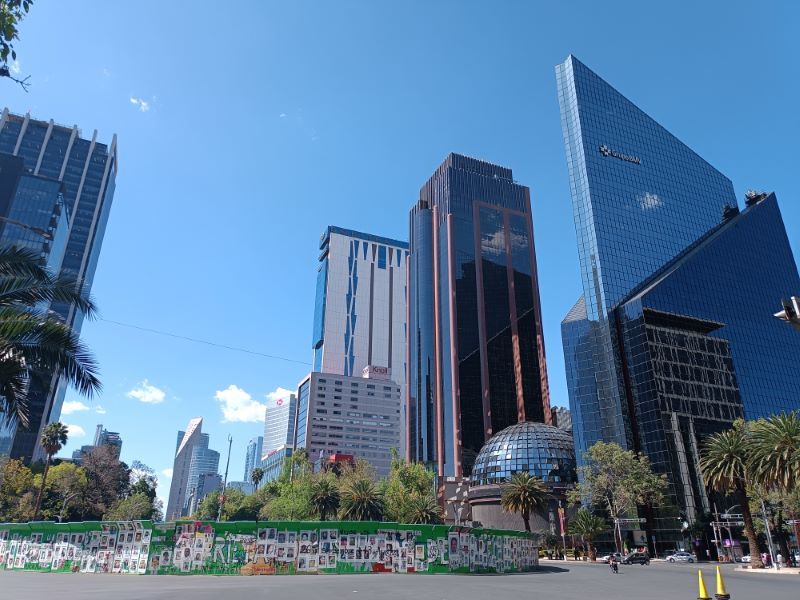
Restaurants are plentiful, but not always cheap, depending on your tastes. Mexico City’s food scene is the best in the country. You’ll find everything, including budget-friendly restaurants with authentic Mexican cuisine and upscale international cuisine.
There is an abundance of street vendors selling everything, ranging from tacos to tamales to tortas at very reasonable prices.
You won’t spend as much money on electricity because of the cooler climate. You’ll also find competitive rates for high-speed internet, cable, and phone services.
Transportation costs vary per individual. Having a car is not really necessary in Mexico City. The public transit system in Mexico City is the best in the country and is affordable.
Healthcare in Mexico City
Mexico City has some of the best healthcare in Mexico. There are top-notch hospitals that revival the best research and healthcare facilities around the world.
Mexico City is home to 402 hospitals, which is the most of any city in Mexico. There are over 50,000 doctors and specialists practicing in Mexico City, many of whom studied in the United States and speak English, which is a plus for Americans.
The city boasts the highest number of hospital workers in the country. Many staff members at medical offices and hospitals also speak English, which helps with making appointments and understanding procedures.
The two best public hospitals in the country are in Mexico City.
- IMSS-Centro Medico Nacional Siglo XXI ranks very high for specialists, technology, and patient care.
- IMSS-Centro Medico Nacional La Raza is recognized for its high-quality care and advanced technology.
Three private hospitals, which are continually ranked amongst the best in the world, are in Mexico City.
- Medica Sur is part of the Mayo Clinic and scores high marks for patient safety and quality of care.
- Hospital Español receives recognition for its talented staff, thorough processes, and state-of-the-art technology.
- Centro Medico ABC’s Santa Fe Campus is recommended for the overall quality of care and patient satisfaction.
English-speaking dentists, psychologists, physical and occupational therapists are found easily. Many pharmacies have English-speaking employees to assist you.
Lifestyle in Mexico City
Mexico City is the perfect environment for Americans who like the hustle and bustle of a large city. It’s also a great place for people who want to fully immerse themselves in Mexican culture to become acclimated to the language, history, and people of Mexico.
Americans can enrich their lifestyle with the performing arts, including theater, symphony, ballet, and musical events. Mexico City is also a great sports town with two major soccer teams, an active NBA G-League team, major boxing events, and the whimsical Lucha Libre wrestling circuit.
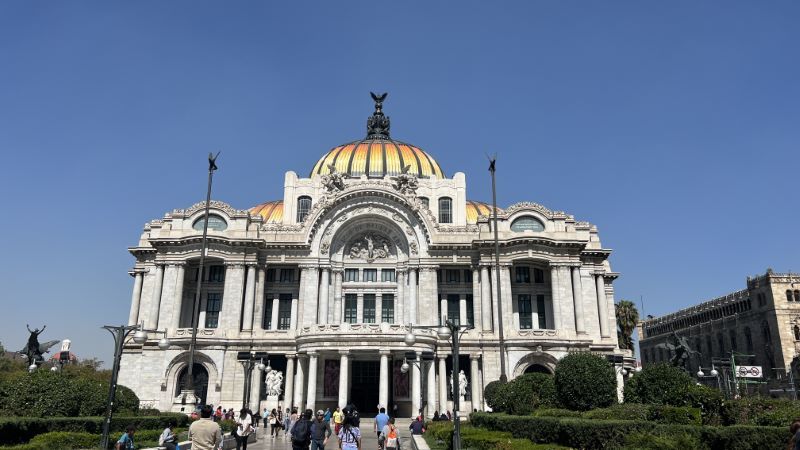
Americans are also pleased with shopping in Mexico City, including high-end clothing stores, American-style grocery stores, and many of the same conveniences found in large cities across the United States.
The city has plenty of green spaces and parks for Americans to jog, ride their bike, or just take a stroll.
The food scene in Mexico City is very diverse. You’ll have no problem finding tasty cuisine from around the world, from traditional Mexican to French to Chinese to Indian to a variety of well-known ordinary fast-food chains.
Safety in Mexico City
Mexico City’s crime rate is comparable to Atlanta, Chicago, or Houston in the United States. The crime rate over the last five years has increased at the same rate as other large cities in Mexico and around the world.
According to the indexes, crime is high in Mexico City. Crimes of all types rate high in Mexico City, from robbery to physical attacks to petty theft.
You’ll feel moderately comfortable walking the streets during the day, an astonishing 52% of the time in Mexico City. At night, this number drops lower to 24% when you’re walking the streets alone. The numbers reflect the population of a large urban area.
Who Should Live in Mexico City?
Mexico City is a place for Americans looking for a large city that never sleeps. Business professionals, retirees, digital nomads, and students all find themselves at home with the hustle and bustle of the city’s large population.
The city can be a playground for someone who wants to explore the cultural aspects of Mexico’s history and people. If you’re someone willing to immerse yourself in the culture of the country, then you’ll thrive at the fast pace of life.
It’s probably not a place for someone who doesn’t speak much Spanish or who is interested in spending time with only fellow Americans.
Best Neighborhoods in Mexico City
Mexico City has several neighborhoods that Americans cherish. Rent is higher in these neighborhoods, but safety and the quality of life are better. You’ll also need a guarantor to sign your lease with you.
You can expect to pay between US$1,200 and US$1,600 for a one-bedroom apartment, US$1,750 to US$2,500 for a two-bedroom apartment in these neighborhoods.
- Polanco attracts Americans searching for luxury, safety, and an elegant atmosphere. Here you’ll find plenty of high-end dining options, shopping, American-style grocery stores, and easy access to the Metro. Here you’ll find larger complexes with high-quality amenities, like swimming pools, gyms, and larger hacienda-style homes behind large walls.
- Coyoacan is a historic neighborhood featuring a relaxed and cultural environment. It has a small-town feel with cobblestone streets, tree-lined streets with residential homes, and plenty of cultural landmarks, including the Frida Kahlo Museum. You’ll find a traditional Mexican market for all of your grocery needs nestled within quiet streets.
- Roma is popular with Americans of all ages and sports a grittier feeling than its sister neighborhood, Condesa. There are plenty of restaurants, the streets feel safe, and you’ll be surprised by how easy the area is to walk and enjoy.
- Condesa is packed with vintage Art Deco architecture, tree-lined streets, and big green parks. It’s popular with trendy Americans, digital nomads, and retirees because of easy access to shopping, boutique restaurants, and events.
Here is a complete guide on how to find a rental property in Mexico City.
Mérida
Merida is an ideal place for Americans who want to learn about different cultures. The city has become a favorite for international businesses, outpacing Monterrey in recent years, blending more cultures into the urban melting pot.
Pros
- Rich in Spanish and Mayan culture. Merida is known for celebrating the mixture of both cultures.
- Merida is close to many beaches and/or cenotes to keep you refreshed from the heat. The city is also within driving distance of several well-known Maya ruins.
- The city has become a hotbed for international businesses, which brings another dimension of cultural experience into play.
- The cost of living is stable and hasn’t grown as fast as in other cities within Mexico.
Cons
- Merida is hot and humid throughout the year. It’s also vulnerable to hurricanes and tropical storms, bringing heavy rains and strong winds.
- A car or motorcycle is needed to get around the city and the surrounding area.
- The language barrier in Merida may frustrate some Americans without moderate-level Spanish-speaking ability.
- There is a smaller American community living within and around the city.
Cost of Living in Merida
You’ll need between US$1,300 and US$1,750 to live comfortably in Merida. You’ll spend most of your budget on rent, utilities, transportation, restaurants, and groceries.
Merida has several public markets around the city for fresh produce, vegetables, and meats. You’ll find a Sam’s Club, Costco, a La Comer, and other familiar grocery stores selling American-style foods, which tend to be pricier.

Restaurants are plentiful, but not always cheap, depending on your tastes. There are fewer street vendors in Merida, except in the Centro area, selling everything from tacos to tamales to tortas at very reasonable prices.
You’ll spend more money on electricity because of the hot climate. Air conditioning in your home in Merida can get expensive, costing upwards of US$300 every two months. You’ll find competitive rates for high-speed internet, cable, and phone services.
Transportation costs vary per individual, but you’ll want a car or motorcycle in Mérida. Having a car increases your living expenses due to the cost of gas, insurance, and maintenance.
Fortunately, newer infrastructure in Merida eliminates some maintenance problems.
The public transit system is affordable, but it is not as comprehensive as in Guadalajara, Mexico City, or Monterrey.
Here is a detailed breakdown of the cost of living in Merida.
Healthcare in Merida
Healthcare in Merida is excellent. You’ll have lots of options for hospitals, clinics, pharmacies, dentists, and other health professionals.
The diverse community of universities, trade schools, and an assortment of international businesses has helped elevate the healthcare system in Merida.
There might be a language barrier issue with assistants, but there are plenty of bilingual doctors and specialists.
Merida is home to two public hospitals that offer new technology and medical services.
IMSS Hospital 12 of Yucatán, and IMSS Hospital 1 of Yucatán. Each hospital is fully equipped with modern medical equipment that can handle any type of medical procedure.
A bonus to these IMSS hospitals is that most doctors and specialists are bilingual or multilingual. Staff members also have a good grasp of English.
You’ll find two private hospitals in Merida.
- Centro Medico de las Americas boasts a blood bank, emergency adult care, coronary care, and nuclear medicine. The hospital has multilingual doctors and staff for your convenience. They are affiliated with Mercy Hospital in Miami, Florida.
- Starmedica is part of a larger chain of Mexican hospitals and is the newest hospital in Merida. The doctors and staff are multilingual, with over 30 specialists available to assist you with your healthcare needs.
You’ll be happy to know that in Merida, there are dentists, therapists, psychologists, and other medical professionals who speak English.
Lifestyle in Merida
Merida’s lifestyle is different than most cities in Mexico. There are plenty of activities within the city to keep you busy, from cultural events to museums to historic architecture, but the city’s accessibility to beaches and Mayan ruins makes Merida stand out.
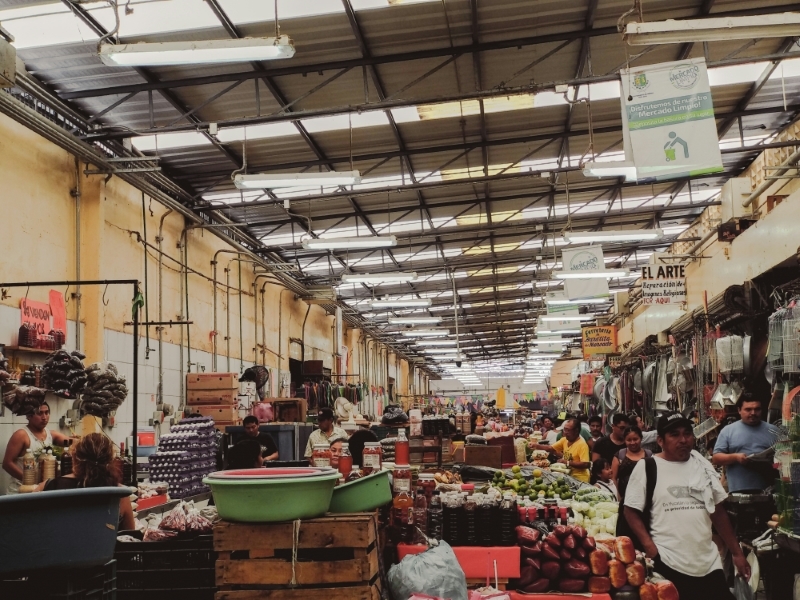
You’ll find the fourth-largest city in Mexico is at times loud and boisterous, as well as gentle and calm. The city’s multilingual and multinational business community helps give the city a cosmopolitan atmosphere that is harnessed by Mexican and Mayan cultures.
There are plenty of green spaces for jogging, biking, or just relaxing. You’ll be thrilled to view the Spanish colonial architecture in the downtown area on a nightly stroll.
Safety in Merida
Merida consistently ranks among the safest cities in Mexico. The crime rate over the last five years has increased at a lower rate than in other large cities in Mexico.
The crime rate in the fourth-largest city in Mexico is similar to Boise, San Diego, and Denver.
You’ll feel safe in Merida. The only crime that reaches a moderate level in Merida is corruption and bribery. All other types of crime rates range from very low to low.
You’ll feel comfortable walking the streets during the day, an astonishing 92% of the time in Merida. At night, this number drops to a comfortable 80% when you’re walking the streets alone.
Who Should Live in Merida?
Merida is a great place for Americans looking for hot weather year-round, who want to absorb the local culture, which is a mixture of Spanish and Mayan culture.
Merida is also a nice place for people and digital nomads looking for American-style amenities, like grocery stores, lower rent, and newer infrastructure.
Merida is gaining popularity with all ages of Americans as an alternative to Playa del Carmen or Cancun, which are pricier.
Merida might not be a good place for an American with limited Spanish skills.
Best Neighborhoods in Merida
When you live in Merida, you’ll be surprised by how reasonable housing costs are without sacrificing amenities.
You’ll find housing runs between US$650 and US$800 for a one-bedroom apartment. Homes are even more affordable, starting at US$750 to US$1,500 for a two-bedroom house with a swimming pool. Three-bedroom homes are priced right at US$1,500 to US$2,500, depending on the neighborhood.
- El Centro Historico is one of the most sought-after areas to live in Merida. The Spanish Colonial architecture is splendid, with many homes featuring courtyards, fountains, and gardens behind tall walls. One caution is that the area gets loud.
- Benito Juárez Norte is situated between El Centro Historico and north of Merida. There are plenty of amenities like shopping, restaurants, and it’s only ten minutes from El Centro Historico. You’ll find a quaint neighborhood with affordable apartments and homes.
- Garcia Gineres is situated within an easy walking distance to El Centro Historico, the neighborhood sports incredible architecture from French Neoclassical to Modernist to Spanish Colonial. Lots of small open spaces, like parks and squares, in the area.
- Cholul is a growing neighborhood just north of the outskirts of Merida. Here you’ll find newer constructions with housing options that range from apartments to townhouses to houses. There’s also an abundance of newer strip malls and shopping centers nearby, but you will need a car.
- Dzitya is a newer neighborhood west of the city. Here you will need a car, but the options are plentiful for you. You also have access to newer infrastructure, like connecting roads to the central area of Merida. There is open space and parks, a shopping mall nearby, and other amenities.
Lake Chapala (Ajijic/Chapala)
The Lake Chapala area is one of the oldest and largest American expat communities in Mexico. Around 20,000 Americans are living year-round along the northwest portion of Mexico’s largest lake. The American community is active, supportive of each other, and the local culture.
Pros
- Lake Chapala has a large expat community that gives you a sense of belonging and plenty of amenities that will remind you of back home.
- The area around the lake has a pleasant climate with moderate temperatures during all seasons.
- Living by the largest freshwater lake in Mexico is second-to-none, with diverse wildlife and gorgeous vistas overlooking Lake Chapala.
- Ajijic is designated a Puebla Magica by the Mexican Tourism Council and is a special place for many cultural reasons.
Cons
- The language barrier in the city of Chapala can hamper you if you only speak a little Spanish, but you can get by with a basic understanding.
- Residents in Lake Chapala usually find it necessary to own or bring a car for transportation. This depends on your lifestyle and shopping habits.
- No direct international airport flights to the Lake Chapala area. You must travel to Guadalajara.
Cost of Living in Lake Chapala
A monthly minimum income of US$1,600 to US$2,100 is necessary to live a comfortable life in the Lake Chapala area. You’ll find it is about 10% cheaper to live in Chapala than in Ajijic. Most of your monthly budget will be spent on restaurants, groceries, and rent.
The Lake Chapala area has several public markets nestled between Chapala and Ajijic for fresh produce, vegetables, and meats.
You won’t find a Sam’s Club, Costco, or La Comer, but there are major Mexican supermarket chains, including Soriana and Chedraui. You’ll find smaller specialty grocery stores selling American-style foods, which tend to be pricier.
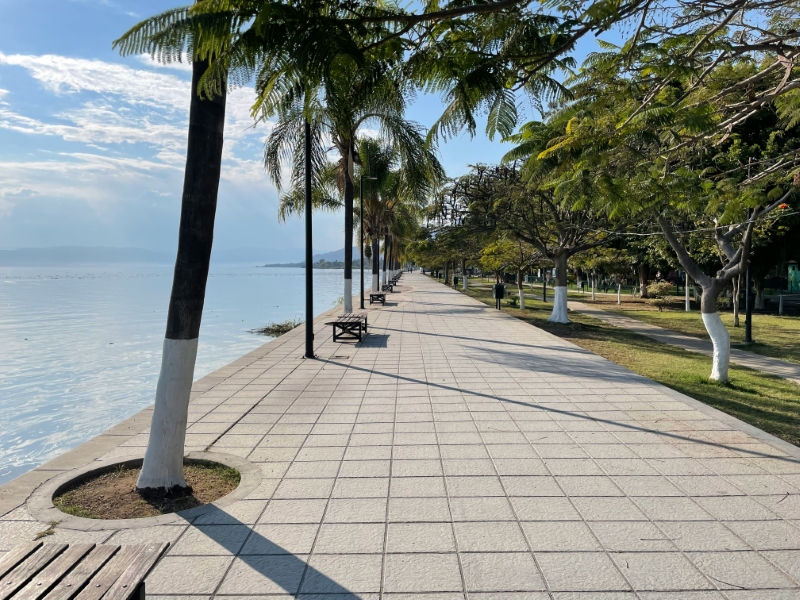
Restaurants are plentiful, but not always cheap, depending on your tastes. There are fewer street vendors in the Lake Chapala area. You’ll find restaurants are more expensive in Ajijic than in Chapala.
Street vendors selling authentic Mexican foods at very reasonable prices are more plentiful in Chapala.
You’ll spend less money on electricity because of the moderate climate. You’ll occasionally need to use your air conditioning. You’ll find competitive rates for high-speed internet, cable, and phone services.
Transportation costs vary per individual. Chapala and Ajijic are very walkable cities.
Most Americans choose to have a car for trips to Guadalajara and around the Lake Chapala area. Having a car increases your living expenses due to the cost of gas, insurance, and maintenance.
The public transit system is affordable, but it is only necessary for commutes between the two communities or to nearby Guadalajara.
Here is a detailed breakdown of the cost of living in the Lake Chapala Area.
Healthcare in Lake Chapala
Healthcare in the Lake Chapala area is good for Americans living in Mexico. There are top-notch health facilities, clinics, and doctors in the area with many English-speaking healthcare professionals.
The Lake Chapala area has one public hospital named IMSS Chapala. The facility offers top-notch medical technology for registered IMSS patients and other life-threatening situations.
There are two private hospitals in the Lake Chapala area. Both hospitals cater to expats and the community with world-class medical services.
- Ribera Medical Center is part of the Lakeside Medical Group. The group has 12 hospitals in several cities in Mexico, including Mexico City and Puerto Vallarta.
- Hospital San Antonio is the newest in the area. The hospital has a limited number of beds, but its medical technology and services are first-class. They offer more than 20 specialists onsite with emergency care and ambulance service.
Lifestyle in Lake Chapala
Your lifestyle in the Lake Chapala area will be pleasantly calm. You’ll find peace for the most part away from the central areas of downtown. There are plenty of activities for active Americans on the lake and in the surrounding foothills.
You’ll find plenty of American-style amenities, ranging from restaurants to grocery stores to healthcare. There are lots of art galleries to visit, and the Malecon practically runs from Ajijic to Chapala.
Families enjoy the quietness of the communities around the Lake Chapala area, and Americans enjoy being able to visit with other like-minded Americans.
If you get bored with the small town atmosphere, you can travel to Guadalajara, which is an easy one-hour drive or bus trip.
Safety in Lake Chapala
Feeling safe is always a priority for expats. You’ll be glad to know that the overall crime rate in the Lake Chapala area has increased very little over the years and is considered moderately stable.
Many of the areas are packed with local expats and tourists, which brings additional police services into play in places like the downtown areas, the Malecon, and the park areas.
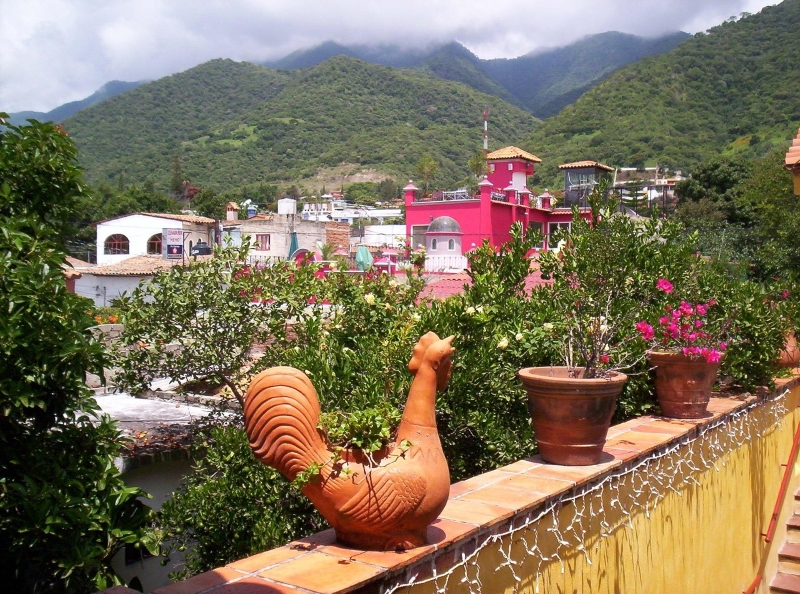
People feel safe 91% of the time when walking during the day and 72% during the evening in Chapala. The safety rating during the day in Ajijic is 92% but drops to 62% when walking at night in the city.
You’ll find moderate crime rates higher in Ajijic for theft, vandalism, home break-ins, and armed robbery. The most reported crimes are bribery and items from parked cars.
Overall, you’ll be reassured by the large number of English-speaking officers and security guards, which helps with anxiety and fear after an incident.
Who Should Live in the Lake Chapala Area?
The Lake Chapala area has one of the oldest and largest American communities living in Mexico. If your Spanish is questionable, then the Lake Chapala area is ideal for you.
If you like a mild climate with warm days and chillier nights, then Lake Chapala is perfect for you.
Artists, retirees, and younger active Americans like the area for various activities, from watersports on the lake to hiking in the foothills to bike riding to walking the Malecon.
Americans, who are looking for plenty of American-style amenities in a relaxed setting, seem to thrive here.
Best Neighborhoods in Lake Chapala
Each of the communities along Lake Chapala offers a wide choice of housing in a wide price range. There are numerous gated communities in the outlying areas of each location, and you’ll need transportation to take advantage of that lifestyle.
Ajijic features a mixture of Colonial and Mexican-style architecture. Rent for a one-bedroom apartment starts at US$700 to US$1,000. For a two or three-bedroom home, you can expect a range from US$1,500 to US$3,500.
Chapala has narrower streets in the central area, and they get wider as you travel up the hill. Housing in Chapala tends to be cheaper than in Ajijic. Rents will range from US$450 to US$600 for a one-bedroom apartment. Two-bedroom homes with a small garden start around US$700 to US$2,000.
- Brisas de Chapala is farther up the hillside with nice mountain vistas and streets that wind up and down the hillsides. The gated community is very peaceful and quiet, which makes it popular with well-to-do local families and expats.
- La Christiana is a popular neighborhood situated near the Malecon and encompasses most of downtown. It’s popular with younger expats, working-class locals, and you’ll be close to plenty of amenities, from shopping to dining to nightlife.
- La Parota is north of downtown and La Cristiana. It is popular with the local working-class and American expats on a budget. It has similar aesthetics to La Cristiana, but the homes offer more garden space and are a bit larger.
- Chapala Haciendas is one of the oldest gated communities in the Lakeside area, which is popular with expats and more established local families. In this gated community, you’ll find wide winding streets lined with mature trees and lots of greenery.
Best Neighborhoods in Ajijic
The Downtown Area of Ajijic is highly sought out because of its proximity to the Malecon, dining options, public transportation, and entertainment options.
There is plenty of old-school charm when you walk the streets in the downtown area with mature trees, homes with interior gardens, and at times lots of tourists.
One drawback to the downtown area is noise. The bustling streets never stop with foot traffic or vehicles.
- Las Silvias is a charming neighborhood just outside of Ajijic. The area winds up and through the adjacent hillsides and boasts plenty of beautiful homes. The cobblestone streets are lined with mature trees and lush hanging gardens on the protective stone walls.
- La Floresta is a beautiful area situated between downtown Ajijic and the western portion of San Antonio Tlayacapan. You’ll find stunning architecture in this neighborhood created by Samuel Orozco Beltran. While living in this area, you’ll have access to American-style grocery shopping within a 5-minute walk.
Puerto Vallarta
Puerto Vallarta has been an American favorite for expats of all ages for decades. The large LGBTQ community is warm and welcoming towards all people. The beach areas are plentiful and usually some of the cleanest in Mexico. Your transition to Mexico will be easier with the large American community that exists in Puerto Vallarta.
Pros
- You don’t need to be fluent in Spanish. You can get through most major situations with a beginner’s level of the language.
- The beach. You know, life is always better by the ocean.
- A large American expat community provides support and confidence, and there’s also a sizable LGBTQ community if that’s part of your lifestyle.
- You’ll have access to all American-style amenities, including Costco, Sam’s Club, and other major grocery stores.
Cons
- The cost of living is higher due to the tourist-driven economy.
- During the high season, locals may treat you more as a tourist, and prices for goods and services tend to increase steeply.
- Puerto Vallarta is large and spread out, so owning a car is essential.
- The climate is warm and humid, with a risk of hurricanes and tropical storms.
Cost of Living in Puerto Vallarta
You’ll need a minimum of between US$1,600 and US$2,250 to live adequately in Puerto Vallarta. Puerto Vallarta has a higher cost of living because of its tourist economy. There are notable differences in prices between high and low seasons of tourism.
The minimum amount needed can be adjusted based on your cost of rent, transportation, and factors like grocery shopping and restaurants.
Puerto Vallarta has several public markets nestled in the inner city and along the highways selling fresh produce, vegetables, and meats.
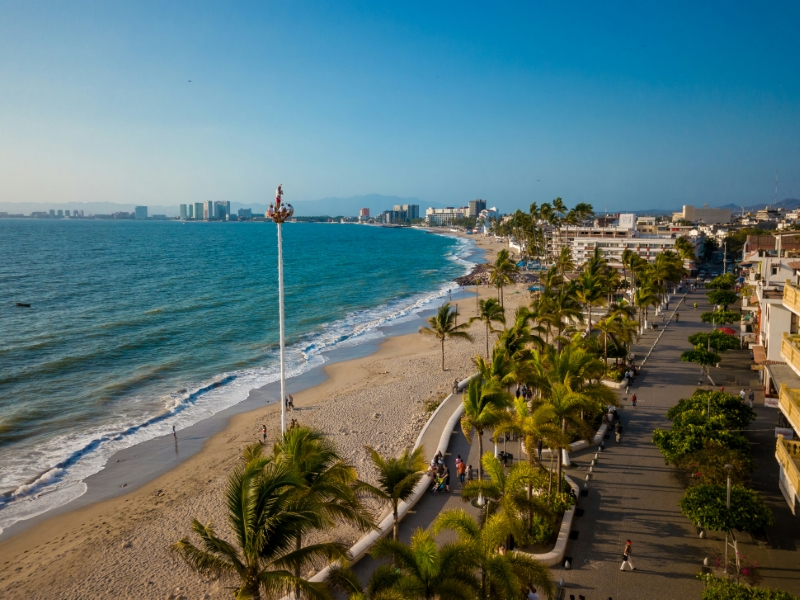
You’ll find a Sam’s Club, Costco, and La Comer, along with other major Mexican supermarket chains, including Walmart, Soriana, and Chedraui.
Restaurants are plentiful and can be pricey, depending on your taste. You’ll find a variety of cuisines alongside traditional American-style fast-food chains. You’ll notice a difference in pricing between tourist seasons.
There are street vendors in the inner city areas and along the Malecon selling everything from tacos to tamales to tortas at reasonable prices.
You’ll spend more money on electricity, depending on your air conditioning use, because of the warm and humid climate. The cost for air conditioning over two months can be as high as US$220. You’ll find competitive rates for high-speed internet, cable, and phone services.
You’ll need some type of transportation for grocery shopping, errands, and accessing secluded beach areas. Transportation costs will be higher. Having a car increases your living expenses due to the cost of gas, insurance, and maintenance.
The public transit system is affordable and easy to use, but it can be a hassle for shopping. Taxis tend to be more expensive because the city is a tourist destination.
Here is a detailed breakdown of the cost of living in Puerto Vallarta.
Healthcare in Puerto Vallarta
Puerto Vallarta has some of the best healthcare options for Americans. The healthcare system in Puerto Vallarta is modern with updated equipment, medical procedures, dentistry options, and hospital care.
Puerto Vallarta, with its large tourism business, has many doctors, dentists, and specialists who speak English, so the language barrier may only occur when making appointments or at the front desk.
There is one modern public hospital in Puerto Vallarta. The IMSS HGZ 42 Puerto Vallarta hospital was built in 2015. The facility offers state-of-the-art medical equipment for patients who hold plans with IMSS.
Puerto Vallarta has three outstanding private hospitals for your healthcare needs.
- CMQ Hospital Premiere offers state-of-the-art medical equipment and healthcare. It’s conveniently located, boasting healthcare with more than 25 specialists on staff. The doctors and staff are bilingual.
- Hospiten Puerto Vallarta is another option with excellent facilities. The hospital is part of a global network of renowned hospitals. They offer state-of-the-art facilities, bilingual doctors and staff, and easy insurance options.
- Medassist Hospital has been operating in Puerto Vallarta for over 30 years. The facility is updated continually with state-of-the-art technology. They offer bilingual doctors and staff in more than 14 different healthcare issues, like neurology, otorhinolaryngology, urology, traumatology, and more.
Lifestyle in Puerto Vallarta
The lifestyle in Puerto Vallarta is ideal for active Americans of all ages. You’ll benefit from the many beaches, which are within walking distance of many neighborhoods. If you prefer a laid-back atmosphere, you can find a spot in Puerto Vallarta that helps you unwind and enjoy life.
There are plenty of events throughout the year to keep you occupied, especially during Pride month, whether you’re a member of the LGBTQ community or not.
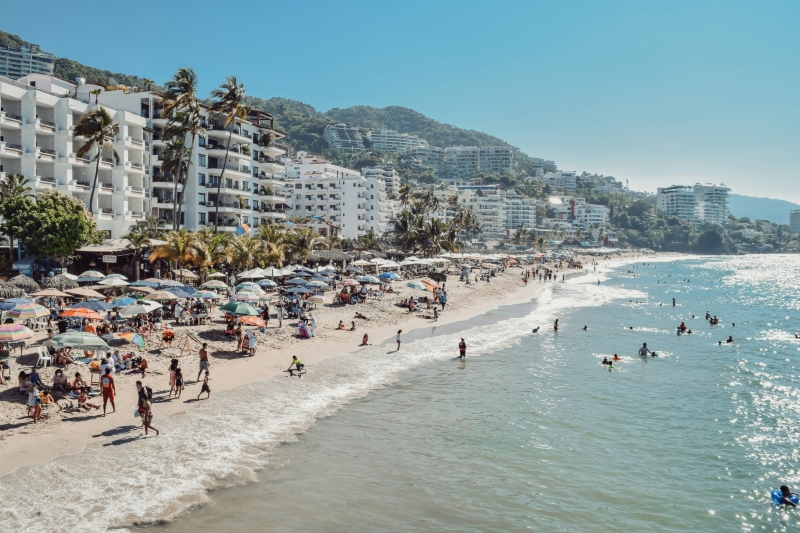
You’ll find plenty of American-style amenities to help you with your transition, and there are plenty of Americans to help you along the way.
You’ll enjoy the food scene, which is loaded with fresh seafood and local dishes. With the city being a tourist destination, you’ll devour plenty of other cuisines from around the world.
Many of the resorts require employees to speak some English, so if your Spanish isn’t the best, you’ll find it easier to communicate with the locals
Safety in Puerto Vallarta
Puerto Vallarta rates well in safety and crime indexes. The lack of crime is due to the higher employment rate associated with tourism. Higher wages help, too.
You’ll find more active police and private security guards in tourist areas compared to larger cities in Mexico, such as Guadalajara, Monterrey, or Mexico City.
You’ll feel safe in Puerto Vallarta. Although crime has steadily increased over the last several years, the figure encompasses all crime activity in the surrounding area. The only portion of crime that is moderate in Puerto Vallarta is vandalism and petty theft.
Major crimes like robbery, homes robbed, or cars stolen are quite low compared to the national average in Mexico. You’ll feel comfortable walking the streets alone during the day over 86% of the time in Puerto Vallarta. During the evening, the rate of safety for walking alone drops to 62%.
Who Should Live in Puerto Vallarta?
Puerto Vallarta is another excellent place for Americans who want to live in a beach town community with fellow American expats. The city boasts an expat community of roughly 45,000 during the high season in winter and some 15,000 that stay all year round.
Puerto Vallarta is sometimes referred to as the San Francisco of Mexico because of its welcoming attitude towards the LGBTQ community. Many believe it’s the most gay-friendly city in all of Mexico.
Retirees, snowbirds, digital nomads, and mid-aged Americans searching for an active lifestyle thrive in this town.
Best Neighborhoods in Puerto Vallarta
Puerto Vallarta has a diverse range of housing options for you to search for that perfect home. There are a few neighborhoods that possess charm, location, and convenience that Americans enjoy.
You can expect to pay US$600 to US$1,200 for a one-bedroom and US$1,500 to US$3,000 for a two-bedroom, depending on location.
- Zona Romantica is part of the south-central area in Puerto Vallarta. Here you’ll find an electric vibe with narrow streets, cobblestones, older architectural styles, and newer construction. It’s also very close to Playa Los Muertos, and there is a friendly LGBTQ community.
- The downtown area puts you right in the middle of everything, including the Malecon. Architecture dates to the 1800s, with lots of Spanish influence, including statues, fountains, parks, boutique shops, and restaurants.
- Gringo Gulch is an area situated alongside the Rio Cuale. The neighborhood is hilly, but offers superb views and brightly painted houses. There aren’t many restaurants or shopping within a short walk, and housing is affordable.
- Marina Vallarta is very close to the airport and is part of a larger resort hotel area. You’ll find easier access to things like golf courses, boating, and beaches. The neighborhood has modern construction, which is a plus for you, but the price depends on the age of the building.
- Conchas Chinas is a ten-minute drive south of the Zona Romantica along Highway 200. The area is different in many ways, with several gated communities perched on the hillsides overlooking the Pacific Ocean, with a variety of modern architecture.
- Emiliano Zapata is an affordable area for you, if you’re on a budget. The neighborhood is situated around the outskirts of Zona Romantica. The area boasts a Mexican feeling, and it’s a short walk to the beach.
Guadalajara
Being the second-largest city in Mexico, Guadalajara is a giant urban playground for Americans to explore and fully immerse themselves in Mexican culture.
Pros
- Guadalajara is the second-largest city in Mexico, offering an affordable, welcoming, and slow-paced environment, unlike Mexico City.
- The city boasts a vibrant Mexican culture mixed with plenty of performing arts like theater, live music, festivals, and sporting events.
- The city has a milder climate for Americans to enjoy, with pleasant warm days and cooler evenings.
- Guadalajara is centrally located for easy weekend getaways to other Mexican destinations, including Lake Chapala and Puerto Vallarta.
Cons
- Guadalajara requires Spanish-speaking skills. Limited Spanish-speaking Americans have a harder time adjusting and won’t transition well into the city.
- Like Mexico City, the city’s safety concerns run high amongst Americans. Know where you’re going and where you’re in the city.
- The city’s public transportation is not as well-developed as in Mexico City or Monterrey. There’s heavy congestion on roads and highways during peak hours.
- Guadalajara is not for an entrepreneur or someone who lacks a job. There are limited opportunities outside of teaching English.
Cost of Living in Guadalajara
An American living in Guadalajara will need between US$1,400 and US$2,000 to live comfortably. Your expenses depend on your lifestyle. You’ll pay a higher rent to be in safer neighborhoods.
Cost of living is lower because of Guadalajara’s logistical routes within Mexico. There’s also a high level of industrial and agricultural production in the city and the surrounding areas.
You’ll find numerous public markets in the city selling fresh produce, vegetables, and meat. You’ll find a Costco, Sam’s Club, and La Comer selling American-style foods, which tend to be pricier. Mexican grocery stores are abundant, including Soriana, Chedraui, and there’s Walmart.
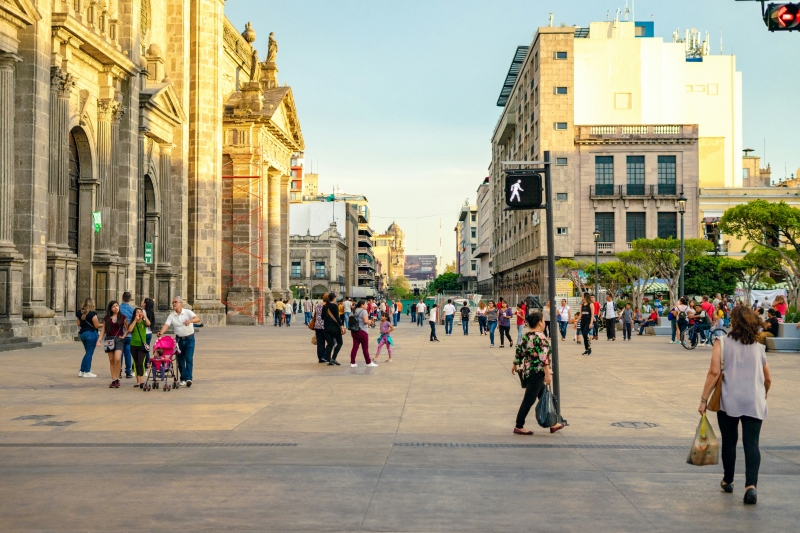
Restaurants are plentiful, with a food scene that is only rivaled by Mexico City. You’ll find hundreds of street vendors with authentic tasting Mexican foods, including tacos, tortas, tamales, and grilled elote.
The international cuisine is abundant. You can find almost any type of cuisine from around the world. There’s no shortage of great spots to eat, ranging from budget meals to fast food to gourmet bistros offering the latest delicacies.
You won’t spend as much money on electricity because of the milder climate. You’ll also find competitive rates for high-speed internet, cable, and phone services.
You’ll need a car or motorcycle to navigate your errands, shopping, and weekend trips. Having a car increases your living expenses tremendously due to parking costs, insurance, gas, and maintenance.
The public transit system is affordable when buying a monthly pass and easy to figure out, but it’s not as impressive as in Mexico City.
Here is a detailed breakdown of the cost of living in Guadalajara.
Healthcare in Guadalajara
There are plenty of public and private hospitals in Guadalajara that offer state-of-the-art medical services. The city has several major research hospitals, similar to those in Mexico City. You’ll find a wide range of medical procedures available.
You might not find as many English-speaking doctors and specialists in Guadalajara. You’ll be able to find general doctors, dentists, and psychologists who speak English.
There are two highly regarded public hospitals in Guadalajara for Americans who choose a healthcare plan with IMSS.
- Hospital 46 IMSS Jalisco is a modern facility offering many types of procedures, ranging from prenatal to cardio to physical therapy to general surgeries. The facility was recently upgraded in 2019.
- IMSS – Centro Médico Nacional de Occidente is also a major medical learning institute with students from around Mexico studying medicine, nursing, and other types of medical services. You’ll find upgraded technology and comfort care.
There are plenty of private hospitals in Guadalajara that offer state-of-the-art medical services. The city has several major research hospitals, similar to those in Mexico City. You’ll find a wide range of medical procedures available.
- Hospital San Javier is highly regarded for its facilities, offering 17 specialists, including services for transplant patients. The hospital draws staff from around the world, but you might find a language barrier with some specialists.
- Hospital Civil De Guadalajara Fray Antonio Alcalde and Hospital Civil De Guadalajara Juan I. Menchaca are from the same hospital provider and offer 88 different treatments between them. The facilities boast new technology and equipment, but fewer English-speaking doctors.
- Hospital Ángeles Del Carmen is one of 26 hospitals this provider operates throughout Mexico. They have a good reputation for patient care and comfort. You’ll find almost any type of specialist you need, and they might speak English.
Lifestyle in Guadalajara
Americans searching for a slow-paced lifestyle in an urban jungle will thrive in Guadalajara. There are plenty of activities to keep you busy, and you’ll enjoy the big city amenities while living in Mexico’s second-largest city.
You’ll find performing arts, including theater, live musical concerts, art galleries, ballet, and there are interesting festivals to keep you entertained. There’s no shortage of live professional sporting events with baseball, basketball, lucha libre, and two soccer teams playing year-round.
You can walk freely in your neighborhood while visiting local restaurants, cafes, and street vendors. The food scene in Guadalajara is only rivaled by Mexico City. There’s high-end shopping to be found.
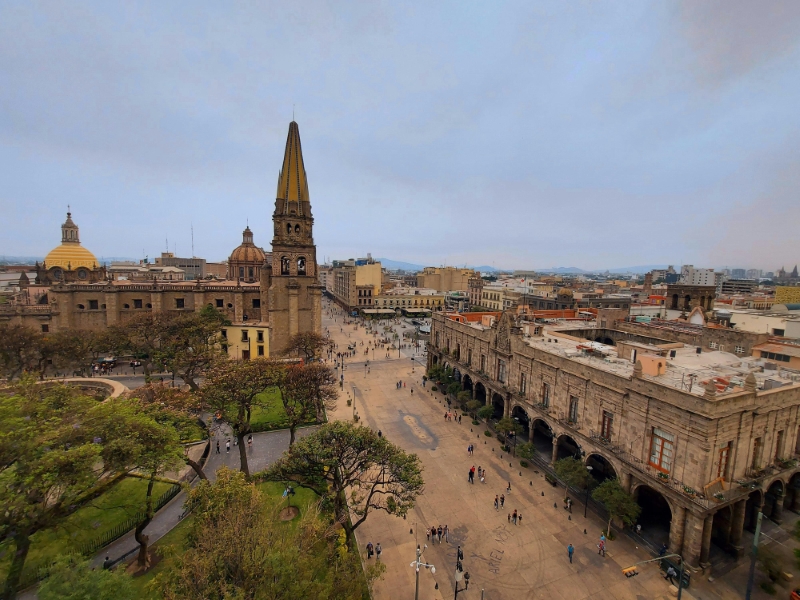
There are not as many Americans as in Mexico City, but there is a thriving international community that keeps Guadalajara glued together for foreigners.
If that’s not enough, you’re within an easy drive to Puerto Vallarta for some beach time, Lake Chapala to visit with your American friends, and a tasty tequila tour just an hour away.
Safety in Guadalajara
Guadalajara’s crime rate is compared to San Francisco, Indianapolis, and Washington, D.C. in the United States. The crime rate over the last five years has increased at the same rate as other large cities in Mexico and around the world.
According to the indexes, crime is high in Guadalajara. Crimes of all types rate high in Guadalajara, from robbery to physical attacks to petty theft. Only home break-ins and being physically attacked are moderate.
You’ll feel moderately comfortable walking the streets during the day, an astonishing 62% of the time in Guadalajara. At night, this number drops lower to 27% when you’re walking the streets alone. The numbers reflect the population of a large urban area.
Who Should Live in Guadalajara?
Guadalajara is the perfect place for Americans looking for a large city without the attitude of Mexico City. You can wander through the second-largest city in Mexico at your own pace.
Life’s a little slower here, but if you need American-style amenities, you’ll find them in Guadalajara. Retirees, digital nomads, and business professionals all enjoy a slower-paced lifestyle.
Guadalajara is not the place for someone who doesn’t speak much Spanish. You’ll have a hard time transitioning to your new home.
The city boasts plenty of activities for Americans to enjoy, and you’re also close to some great weekend getaways.
Best Neighborhoods in Guadalajara
Guadalajara has several neighborhoods that will fit all types of American lifestyles. You’ll need to search for what best suits your needs, and you may or may not need a guarantor to sign your lease with you.
Plan on spending between US$450 to US$800 for a one-bedroom apartment, with a two-bedroom place starting around US$750 to US$1,200. Houses can be pricier, from US$900 to US$4,500.
- Colonia Americana is ideal for younger people looking for a bohemian and trendy neighborhood. You’ll find a mixture of old and new architecture, plenty of restaurants and trendy cafes, walkable streets, and you’ll be near Avenida Chapultepec for nightlife.
- Providencia is a great neighborhood for retirees and families concerned about safety. You’ll find a mixture of high-end restaurants, supermarkets, doctor facilities, and well-maintained parks within walking distance.
- Jardines de Country is a quiet residential area with a country club setting. You’ll be close to hospitals, golf, tennis, shopping, universities, and a variety of restaurants, from cafes to specialty cuisine.
- Chapalita is a family-friendly residential area just outside the metropolitan area. The area attracts Americans, who are looking for a combination of dining options, safety, quietness, green open spaces, and parks.
Playa del Carmen
Playa del Carmen has become a go-to place for Americans wanting to live in Mexico. The lure of the white sandy beaches, the Caribbean Sea, Mayan ruins, and a trendy, upscale attitude has propelled the city into the spotlight.
Pros
- Playa del Carmen is a very cosmopolitan city with an international feel. The food and high-end shopping scene is attractive to many Americans.
- The city offers a laid-back beach-style life.
- Playa del Carmen is perfect for people with a basic understanding of the Spanish language.
- The city boasts proximity to many Mayan ruins and the Yucatan Peninsula.
Cons
- Congestion and the continuing construction of new infrastructure can be irritating to residents.
- Playa del Carmen is susceptible to weather events like hurricanes and tropical storms, which bring heavy winds and torrential downpours.
- The city can get overrun with tourists, especially from December to August.
- Playa del Carmen doesn’t have an international airport. You’ll need to fly in and out of Cancun, Cozumel, or Tulum.
Cost of Living in Playa del Carmen
Americans will need between US$1,800 to US$2,400 live a comfortable life in Playa del Carmen. You’ll find that prices don’t fluctuate much from low to high tourist seasons, like in Puerto Vallarta.
You’ll spend a good portion of your budget on housing, food, and restaurants. Remember, you’re competing with plenty of tourists, whether they are staying directly in Playa del Carmen or at one of the many all-inclusive resorts.
Food costs in Playa del Carmen are 15-25% lower than in the United States. You’re not going to find local markets like in other areas of Mexico, which adds to your food costs.
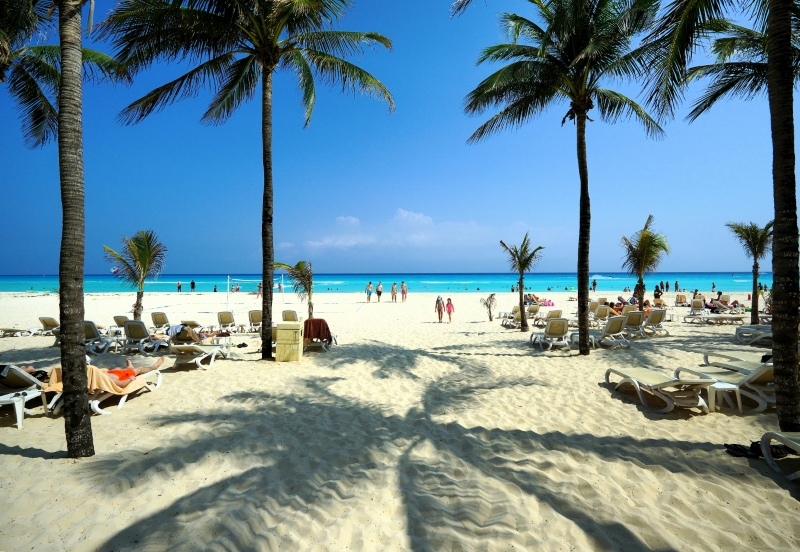
You’ll find plenty of American-style amenities when you shop for groceries. The city boasts a Sam’s Club, and you can make a trip to Cancun if you prefer Costco.
You’ll find there is a Soriana, Chedraui, and a Walmart in the most populated areas of the city and the city center. Unlike other locations in Mexico, these Mexican supermarkets carry a variety of American and international foods at reasonable prices.
Restaurants are plentiful, serving a variety of international cuisine and authentic Mexican dishes from around the country. Restaurants can be pricey, and prices might fluctuate between tourist seasons. You won’t find a great deal of street vendors selling food unless you travel a few blocks from Fifth Avenue.
You’ll find electricity a bit higher because of the warmer climate. If you need your air conditioning, you can expect to pay upwards of US$200 every two months for electricity.
Other utilities, including high-speed internet, phone service, and cable, are 30-50% cheaper in Playa del Carmen.
Transportation costs vary based on an individual’s lifestyle. Most Americans living in Playa del Carmen own a vehicle or motorcycle, which adds the cost of gas, insurance, and maintenance to monthly expenses.
Healthcare in Playa del Carmen
Healthcare in Playa del Carmen is good. Unlike other beach towns, including Puerto Vallarta and Cancun, the hospitals have been recently constructed. Each facility offers English-speaking personnel, ranging from assistants to nurses to doctors and specialists.
Hospital 18 IMSS Quintana Roo is a newer facility for Americans with IMSS insurance. The personnel may not always be English-speaking, but you’ll find bilingual doctors. The hospital offers a variety of medical services and care for its patients.
There are three superb private hospitals in Playa del Carmen. Each offers a variety of medical services with English-speaking specialists on site.
- Hospiten Riviera Maya is a member of the Hospiten network that operates 20 hospitals in the Caribbean and Spain. The facilities are state-of-the-art and offer medical services for 10 specialty health areas.
- Costamed Playa del Carmen is part of the Costamed network that operates five other hospitals in Quintana Roo. They boast upgraded medical technology and medical services for 33 medical specialties.
- Hospital Joya Playa Del Carmen is the newest hospital built in Playa del Carmen. Opening in 2023, the hospital is part of a larger network of six hospitals in Mexico. They offer more than 30 specialties and subspecialties, which guarantee adequate care for all our patients
Lifestyle in Playa del Carmen
Playa del Carmen has grown rapidly over the last ten years. Unlike Puerto Vallarta, Playa del Carmen has an international influence and residents. You’ll find enclaves of Italians, Israelis, Germans, and people from the United Kingdom living year-round in the city.
The American community has grown along with the city and tourism industry. More Americans are living in Playa del Carmen than in Cancun or Merida combined.
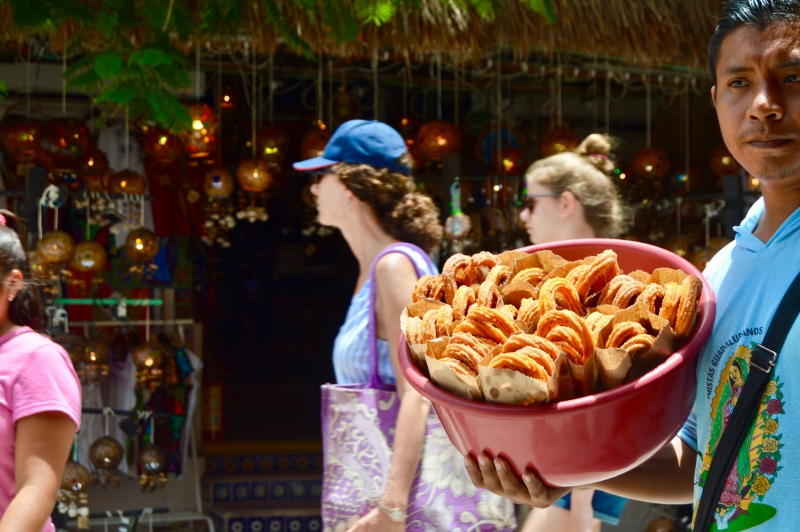
Playa del Carmen boasts an active and laid-back lifestyle. You’ll find plenty of watersport activities along with adventure. Many Americans like the proximity to several prominent Mayan ruins.
You’ll find a variety of interesting events centered around the Mayan culture. Since most of the local employees emigrated from other Mexican states, there is a varied Mexican culture based on the individual’s home state or town.
There are plenty of attractions in the area to experience, including the fantastic beaches, but at times, you might get tired of the heavy tourism industry that attracts people from around the world.
Safety in Playa del Carmen
Playa del Carmen is a moderately safe city for Americans to live. It’s safer than Cancun to the north and Tulum to the south. The tourist industry brings more municipal police personnel and private security guards into play on the streets and public areas.
Crime has increased over the last five years, like most towns around the world. The highest level of crime involves drugs. Most other crimes are all rated low to moderate by several indexes.
Americans walking the streets alone during the day in Playa del Carmen feel safe 82% of the time. At nighttime walking, the safety rate drops to a moderate 57%
Who Should Live in Playa del Carmen?
Playa del Carmen boasts a great lifestyle for Americans, ranging from digital nomads to families to retirees. The town is also an entrepreneur’s dream come true, with plenty of opportunities for investors and future business owners with capital looking to spread their wings.
The laid-back attitude mixed with a high-paced tourist industry is perfect for active Americans, who like the beach and adventure.
You won’t need to have a high level of Spanish-speaking knowledge. You’ll be given the chance to upgrade your language skills by learning some basic Mayan words. But you’ll find sufficient English-speaking individuals at banks, grocery stores, restaurants, and shopping centers.
Best Neighborhoods in Playa del Carmen
Neighborhoods in Playa del Carmen favored by Americans tend to be higher in rent but safer. The closer you live to Fifth Avenue, the louder it gets with nearby restaurants, nightlife, and tourist traffic. But you’re within walking distance to high-end shopping and grocery stores.
Depending on location, you can expect rent to be around $500 for a studio, $1,200 for a one-bedroom condo, and $3,000 for a three-bedroom home. Remember, as with all beach towns, the closer you are to the water, the more you’ll pay.
- Central Area around Fifth Avenue is ideal for those looking for a lively scene and quick access to the beach. You’ll find a mixture of newer buildings offering rooftop pools, onsite gyms, and parking.
- Playacar is a great choice for Americans searching for a quiet space and security. The gated community boasts easy access to beaches, plenty of residential homes, a championship golf course, and access to grocery shopping.
- Zazil-Ha is ideal for families and Americans looking for a safe residential feeling. You’re still close to many of the city’s amenities, like the beaches, grocery stores, and shopping in the centro area.
- Colonial Hollywood attracts digital nomads and residents who are searching to walk to restaurants, parks, and grocery stores. You’re also within easy walking distance of the beaches, and the noise level is minimal.
- Gonzalo Guerrero is perfect if you want to be close to Centro in a quieter setting. You’ll find fewer apartments and more residential opportunities to either rent or buy. You’ll be within walking minutes of several grocery stores, restaurants along Constituyentes, and a couple of beaches.
Other Worth-Mentioning Cities
There are other cities in Mexico for Americans to enjoy and live a superb lifestyle. Here are a couple more ideas for you to ponder.
San Miguel de Allende
A thriving American community that continues to grow every year. You’re within an easy drive or bus ride to Queretaro, Leon, or Mexico City. The milder climate helps Americans when transitioning to Mexico.
Pros
- You’ll enjoy the climate where you can feel the change of seasons. Temperatures are moderate in the summertime and chilly in the wintertime, and there’s hardly any rain.
- You’ll experience a large and growing established American expat community.
- San Miguel de Allende has great access to American-style amenities, including healthcare, shopping, and restaurants.
- The city is a UNESCO World Heritage Site with incredible architecture, lots of cultural events, and activities to keep you busy. The city center is also very walkable and safe.
Cons
- No international airport. You need to travel to Queretaro, Leon, or Mexico City for an international flight.
- The cost of housing has increased over the last few years, pricing some out of the market.
- Your Spanish-speaking ability needs to be a bit better to fully interact with locals. Many residents speak English, but if you’re relying on public transportation, speaking Spanish is a necessity.
Here is a detailed breakdown of the cost of living in San Miguel de Allende.
Cozumel
Cozumel has attracted Americans for decades with its world-class scuba diving and clear Caribbean waters. The American community in Cozumel is tight, and many are business owners who have lived on the island for years. If you’re looking for a town in a tropical beach climate that still feels small, then Cozumel is great for you.
Pros
- A laid-back island lifestyle with lots of water sports activities, thanks to the Caribbean Sea.
- The cost of living in Cozumel is cheaper than in most other beach cities in Quintana Roo, like Tulum, Playa Del Carmen, and Cancun.
- You’ll find all the necessary American-style amenities right on the island, with added nightlife and entertainment.
- You’ll need a basic level of Spanish-speaking ability. The tourist industry in Cozumel has helped many locals learn a high level of English.
Cons
- The weather in Cozumel gets quite hot and humid during the summer and fall months. The island is susceptible to hurricanes and tropical storms, which bring heavy rain and fierce winds.
- Cruise ships bring thousands of tourists to the island every day during the high season from winter to spring. But they do leave in the evening.
- Your cost of living for specific grocery items in Cozumel is higher. Specialty foods, like imported cheeses, are even more expensive.
- You can feel isolated at times, living on an island. It’s good to take the ferry to the mainland.
Here is a detailed breakdown of the cost of living in Cozumel.
Comparing Cities in Mexico for American Expats
Here’s a quick comparison of the most popular cities for Americans. Each offers a different lifestyle, climate, and type of community.
| City | Vibe | Climate | Safety | Healthcare | Car Needed? | Expat Scene | Best For |
| Mexico City | big city, culture, food | mild days, cool nights | medium | excellent, many English-speaking doctors | no | large, mixed ages | culture, jobs, food lovers |
| Guadalajara | urban but slower than CDMX | warm days, cool nights | medium | strong mix of public and private | helpful | medium, growing | city life without CDMX pace |
| Mérida | colonial, family friendly | hot and humid year-round | high | good, several new hospitals | yes | medium, rising | safety, families, culture |
| Lake Chapala (Ajijic/Chapala) | lakeside, village feel | mild year-round | high by day | good, expat-oriented clinics | helpful | very large, retiree heavy | retirees, walkers, artists |
| Puerto Vallarta | beach city, LGBTQ-friendly | warm, humid | medium-high | very good private options | yes | large, seasonal | beach life, snowbirds |
| Playa del Carmen | beach, international mix | warm, humid | medium | modern private hospitals | helpful | large and young | beach plus amenities |
| San Miguel de Allende | artsy, UNESCO | mild days, cool nights | high | good private options | helpful | large, established | culture, walkable center |
| Cozumel | small island, dive hub | hot, humid | medium-high | good, island scale | helpful | medium, tight-knit | divers, quiet beach life |
Where Should You Live in Mexico?
This is the tldr version to help you quickly choose the best place to live in Mexico as an American.
- Mexico City: This is for those who want big-city life, culture, and food. The weather is mild, public transport is excellent, and healthcare is world-class. You don’t need a car, and there are plenty of English-speaking doctors. However, it can be too busy. Cost of living is also quite high.
- Guadalajara: A lively city with strong traditions and a slower pace than Mexico City. The weather is pleasant, and it’s more affordable. You’ll need a car for errands and weekend trips, but it’s a great mix of culture and convenience.
- Mérida: Safe, cultural, and family-friendly. The city is hot and humid but very secure. A car helps if you want to explore beaches or cenotes. It’s ideal for those who want peace and local culture. But you should be able to speak some Spanish to live here.
- Lake Chapala (Ajijic/Chapala): A small-town community with a large expat population. The climate is mild, life is peaceful, and costs are reasonable. It’s the place that you rarely need to adjust your life since many Americans are living here.
- Puerto Vallarta: A classic beach city with a friendly, open community. The weather is warm and humid, and healthcare is good. It’s a great place for beach lovers and retirees.
- Playa del Carmen: Trendy and international with a laid-back beach vibe. The weather is warm year-round, and healthcare is modern. It’s great for digital nomads and younger expats.
However, please note that this article is based on my experience living in Mexico and my talk with other fellow expats. Some people may have different opinions and Mexico is a big city.
So to find out the best place to live here, nothing beats exploring and seeing it with your own eyes. And everyone has a different perfect place.
For me, I’ve been living in different parts of Mexico over the years and now live in a small town in southern Veracruz. It’s a perfect place for me. But I didn’t add it to this article since it’s definitely not suitable for many people. It’s a laid-back town, very local, and you need to speak Spanish to live here.






